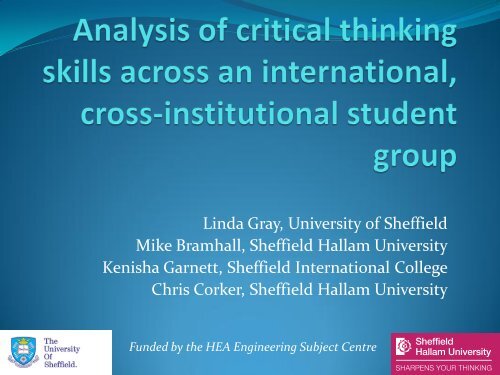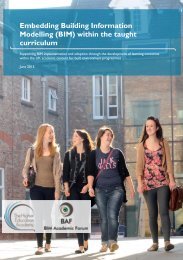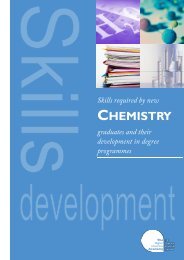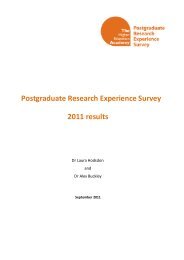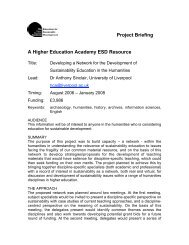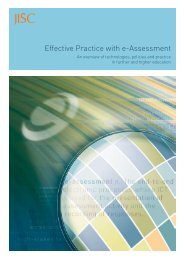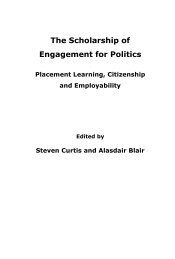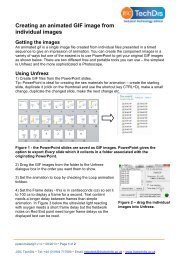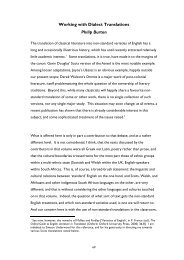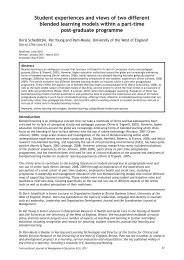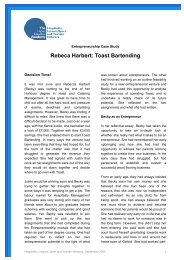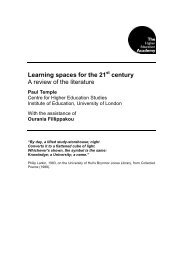Analysis of critical thinking skills across an international, cross ...
Analysis of critical thinking skills across an international, cross ...
Analysis of critical thinking skills across an international, cross ...
You also want an ePaper? Increase the reach of your titles
YUMPU automatically turns print PDFs into web optimized ePapers that Google loves.
Linda Gray, University <strong>of</strong> Sheffield<br />
Mike Bramhall, Sheffield Hallam University<br />
Kenisha Garnett, Sheffield International College<br />
Chris Corker, Sheffield Hallam University<br />
Funded by the HEA Engineering Subject Centre
Overview <strong>of</strong> presentation<br />
• Background information on <strong>critical</strong> <strong>thinking</strong><br />
• Aim <strong>of</strong> the project done (EngSC Mini-Project)<br />
• Research carried out<br />
• Conclusions <strong>an</strong>d the way forward<br />
• Open discussion
Background information on <strong>critical</strong><br />
<strong>thinking</strong><br />
• Critical <strong>thinking</strong>: a mental attitude, a set <strong>of</strong> <strong>skills</strong>, a<br />
high level activity<br />
• Skills:<br />
• Deep <strong>an</strong>d evaluative reasoning<br />
• Critical or questioning attitudes<br />
• Deep subject knowledge<br />
• Link to cultural context
Confuci<strong>an</strong> style <strong>of</strong> learning<br />
• Tradition <strong>of</strong> respect for teachers (unquestioning)<br />
• Some prevalent characteristics:<br />
• Teacher tr<strong>an</strong>smits information <strong>an</strong>d student receives it<br />
• Dislike <strong>of</strong> ambiguity<br />
• Analytical with respect to detail <strong>an</strong>d sequence<br />
• Accustomed to visual learning<br />
• Expectation that better students will help weaker<br />
students
Socrate<strong>an</strong> style <strong>of</strong> learning<br />
• Encouraged to challenge <strong>an</strong>d probe<br />
• Find <strong>an</strong>swers to questions, rather th<strong>an</strong> receive <strong>an</strong>swers<br />
to questions<br />
• Use <strong>of</strong> investigation/inquiry <strong>an</strong>d reasoning to solve<br />
problems<br />
• Teaching through dialogue<br />
• Well-suited to auditory learners
Engineering, <strong>an</strong>d the requirements<br />
<strong>of</strong> the UK-SPEC<br />
• Subject specific knowledge<br />
• Ability to<br />
• Apply concepts laterally<br />
• Integrate <strong>an</strong>d synthesize knowledge<br />
• Analyse <strong>an</strong>d classify information<br />
• Choose the right tool to solve a problem<br />
• Deal with limitations <strong>an</strong>d uncertainty<br />
• Evaluate outcomes<br />
• Student control <strong>of</strong> own learning processes<br />
• Levels <strong>of</strong> Bloom’s taxonomy
Image taken from Clark, D. R. (2004), Instructional System Design Concept Map. Retrieved 3 June 2011 from<br />
http://www.nwlink.com/~donclark/hrd/bloom.html Used with permission.
Aims <strong>of</strong> the project<br />
• Project funded as <strong>an</strong> HEA EngSC mini-project<br />
• Aim: to explore engineering students’<br />
conceptualisation <strong>of</strong> <strong>critical</strong> <strong>thinking</strong>, with a view to<br />
using the findings to contribute to improved design <strong>of</strong><br />
academic programmes in the future.
Research carried out<br />
• Focus groups (Video Clip from Focus Group)<br />
• One at each institution<br />
• Sheffield Hallam University - 21 Students<br />
• The University Of Sheffield - 9 Students<br />
• Responses used to develop questionnaire<br />
• Questionnaires<br />
• Distributed to students on two taught Masters programmes<br />
• 109 responses overall<br />
• 54 from The University Of Sheffield<br />
• 55 from Sheffield Hallam University
Nationality groupings<br />
Sp<strong>an</strong>ish, 1%<br />
Pakist<strong>an</strong>i, 2%<br />
Syri<strong>an</strong>,<br />
1%<br />
Thai, 3%<br />
Nigeri<strong>an</strong>, 12%<br />
Malaysi<strong>an</strong>, 13%<br />
Liby<strong>an</strong>, 3%<br />
Ir<strong>an</strong>i<strong>an</strong>, 3%<br />
British, 14%<br />
Bosni<strong>an</strong>, 1%<br />
Brunei, 2%<br />
Bulgari<strong>an</strong>, 1%<br />
Chinese, 17%<br />
Greek, 3%<br />
Indi<strong>an</strong>, 25%<br />
British<br />
Bosni<strong>an</strong><br />
Brunei<br />
Bulgari<strong>an</strong><br />
Chinese<br />
Greek<br />
Indi<strong>an</strong><br />
Ir<strong>an</strong>i<strong>an</strong><br />
Liby<strong>an</strong><br />
Malaysi<strong>an</strong><br />
Nigeri<strong>an</strong><br />
Pakist<strong>an</strong>i<br />
Sp<strong>an</strong>ish<br />
Syri<strong>an</strong><br />
Thai
Grouping <strong>of</strong> attributes for<br />
questionnaire<br />
Grouping<br />
Information m<strong>an</strong>agement <strong>skills</strong><br />
Inquisitiveness, org<strong>an</strong>isation,<br />
systematicity <strong>skills</strong><br />
Problem solving <strong>an</strong>d <strong>an</strong>alytical<br />
<strong>skills</strong><br />
Open-mindedness, reflexivity <strong>an</strong>d<br />
evaluative <strong>skills</strong><br />
Attributes<br />
Information seeking;<br />
Discrimination; Context<br />
<strong>Analysis</strong>; Creativity; Context;<br />
Knowledge Tr<strong>an</strong>sfer; Confidence<br />
<strong>Analysis</strong>; Persever<strong>an</strong>ce; Evaluation;<br />
Prediction<br />
Reflection; Knowledge Tr<strong>an</strong>sfer;<br />
Discrimination; Evaluation;<br />
Context; Flexibility; Openmindedness
Information m<strong>an</strong>agement <strong>skills</strong><br />
Sources used:<br />
• Library (86%), University sites (82%)<br />
• Internet search engines: General (79%), Academic (56%)<br />
Best Sources:<br />
• Reading lists (90%)<br />
• Tutor guid<strong>an</strong>ce (80%)<br />
• Identify relev<strong>an</strong>t articles (78%)<br />
Students recognise import<strong>an</strong>ce <strong>of</strong> exploring background<br />
<strong>an</strong>d context, but need to trust own reasoning <strong>skills</strong>, with<br />
too much reli<strong>an</strong>ce on tutor guid<strong>an</strong>ce <strong>an</strong>d Google.
Inquisitiveness, org<strong>an</strong>isation <strong>an</strong>d<br />
systematicity <strong>skills</strong> (1)<br />
Ability to <strong>an</strong>alyse a large task, break it down into smaller<br />
parts, design solutions, produce prototypes, with<br />
justification for processes chosen.<br />
Masters Project Pl<strong>an</strong><br />
• 67% showed independent <strong>thinking</strong> in saying they<br />
would propose project tasks to supervisor<br />
• 81% preferred to be guided by supervisor<br />
• Most understood need to underst<strong>an</strong>d context (98%),<br />
background (98%), limitations (93%) <strong>an</strong>d scope/ aims<br />
<strong>of</strong> defining the project (92%)
Inquisitiveness, org<strong>an</strong>isation <strong>an</strong>d<br />
systematicity <strong>skills</strong> (2)<br />
Most understood the need to justify their project<br />
methods by comparing a r<strong>an</strong>ge <strong>of</strong> methods, but most<br />
would use methods used in previous similar projects or<br />
use the easiest route.<br />
There appears to be a lack <strong>of</strong> self confidence,<br />
independence <strong>an</strong>d deep <strong>an</strong>alysis in this theme.
Problem solving <strong>an</strong>d <strong>an</strong>alytical <strong>skills</strong><br />
Applying theory to practice within complex problems:<br />
Underst<strong>an</strong>ding –> Propose –> Develop –> Test -> Evaluate<br />
Results showed a systematic approach to problem solving:<br />
• Using expert solutions (91%)<br />
• Reviewing literature (83%)<br />
• Similar problems (85%)<br />
• Agreed to visual presentation <strong>of</strong> data but half would let the reader draw<br />
their own conclusions from these.<br />
Good lateral <strong>thinking</strong> to adapt solutions to fit problems,<br />
Understood need to link theory to experimental results, <strong>an</strong>d<br />
pr<strong>of</strong>iciency with lab based work – exemplar engineering methods,<br />
but need to be confident in their <strong>an</strong>alytical <strong>skills</strong>.
Open mindedness, reflexivity <strong>an</strong>d<br />
evaluative <strong>skills</strong><br />
Reflective practice – making sense <strong>of</strong> similar or<br />
contrasting viewpoints, formulate own, <strong>an</strong>alyse <strong>an</strong>d<br />
learn from experience.<br />
No general consensus <strong>of</strong> what reflective practice is,<br />
perhaps ambiguity in the questions used within<br />
the questionnaire.
Conclusions<br />
• This research, using focus groups <strong>an</strong>d questionnaires, into<br />
<strong>international</strong> students’ conceptualisation <strong>of</strong> <strong>critical</strong><br />
<strong>thinking</strong>, has provided evidence that:<br />
• International engineering students’ underst<strong>an</strong>ding <strong>of</strong> <strong>critical</strong><br />
<strong>thinking</strong> is not well developed.<br />
• International engineering students may, without being aware <strong>of</strong> it,<br />
have a <strong>critical</strong> <strong>thinking</strong> mindset <strong>an</strong>d <strong>critical</strong> <strong>thinking</strong> <strong>skills</strong>.<br />
• Staff observations, that students from some cultural<br />
backgrounds lack <strong>an</strong> underst<strong>an</strong>ding <strong>of</strong> <strong>critical</strong> <strong>thinking</strong>, are<br />
likely to be a result <strong>of</strong> different expectations <strong>an</strong>d<br />
backgrounds in <strong>thinking</strong> processes <strong>an</strong>d in learning styles.
The way forward<br />
• Further <strong>an</strong>alysis <strong>of</strong> data to distinguish between<br />
cultural backgrounds.<br />
• Prepare guid<strong>an</strong>ce for staff on how programmes c<strong>an</strong> be<br />
designed to support <strong>critical</strong> <strong>thinking</strong>, taking account<br />
<strong>of</strong> the different backgrounds <strong>of</strong> students.<br />
• One example <strong>of</strong> this further work would be to include<br />
expl<strong>an</strong>ations <strong>an</strong>d examples <strong>of</strong> <strong>critical</strong> <strong>thinking</strong> in<br />
induction, <strong>an</strong>d include these again in instructions for<br />
project work <strong>an</strong>d assignments.
Questions for you<br />
• At your institution, where is <strong>critical</strong> <strong>thinking</strong> required<br />
in your curriculum?<br />
• Have you experienced different approaches to <strong>critical</strong><br />
<strong>thinking</strong> from different student groups?<br />
• Do you provide <strong>an</strong>y support for students to help them<br />
underst<strong>an</strong>d <strong>an</strong>d practise <strong>critical</strong> <strong>thinking</strong>?<br />
• How are you exploring your students’ <strong>critical</strong> <strong>thinking</strong><br />
<strong>skills</strong>?
Bibliography<br />
Bennett Moore, Z., Faltin, L. & Wright, M. (2010). Critical Thinking <strong>an</strong>d International<br />
Postgraduate Students. Discourse vol 3 pp63-94. Available online at<br />
http://www.prs.heacademy.ac.uk/view.html/PrsDiscourseArticles/152) [Accessed 8 April 2011]<br />
Castle, A., (2006). Assessment <strong>of</strong> the <strong>critical</strong> <strong>thinking</strong> <strong>skills</strong> <strong>of</strong> student radiographers. Radiography,<br />
12, 88-95.<br />
Ch<strong>an</strong>, H.M. <strong>an</strong>d Y<strong>an</strong>, H.K.T., (2007). Is there a Geography <strong>of</strong> Thought for East-West Differences?<br />
Why or why not?, Educational Philosophy <strong>an</strong>d Theory, 39(4), 383-403.<br />
Ch<strong>an</strong>ock, K.,(2010). 'The right to reticence', Teaching in Higher Education, 15: 5, 543 — 552.<br />
Engineering Council (2003), UK St<strong>an</strong>dards for Pr<strong>of</strong>essional Engineering Competence (UK-SPEC).<br />
http://www.engc.org.uk/ecukdocuments/internet/document%20library/UK-SPEC.pdf)<br />
[Accessed 8 April 2011]<br />
Feng, A., (2008). Presentation from 'Culture <strong>of</strong> learning: What? Why? <strong>an</strong>d How? — Enh<strong>an</strong>cing the<br />
academic experience <strong>of</strong> Chinese students Workshop', Sheffield, 26 June 2008, available online<br />
at http://shef.ac.uk/content/1/c6/08/39/87/Sheffield%20Talk%2026-06-08.ppt [Accessed 8<br />
April 2011]<br />
Higher Education Academy, Teaching International Students Project, (2010). Critical Thinking.<br />
Available online at<br />
http://www.heacademy.ac.uk/ourwork/teaching<strong>an</strong>dlearning/<strong>international</strong>isation/alldisplay?ty<br />
pe=resources&newid=ourwork/<strong>international</strong>isation/ISL_Critical_Thinking&site=york<br />
[Accessed 8 April 2011]<br />
Mason, M. (Ed). (2008). Critical <strong>thinking</strong> <strong>an</strong>d learning. Oxford: Blackwell Publishing


